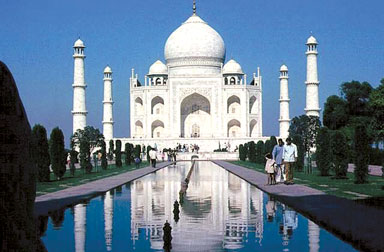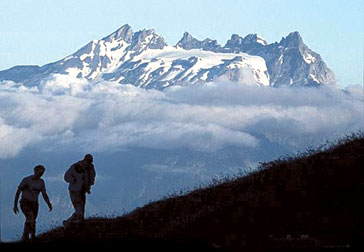Sustainable tourism and economic development in Asia
Travel and tourism is the world’s largest industry and it creates job
opportunities across national and regional economies. Careers generated
by travel and tourism is spread across the economies of countries.
Tourism has such a great multiplier effect, which helps to provide
employment for so many people in various fields.
Due to this factor there are many other industries that are directly
or indirectly related to tourism, helping to create many jobs to employ
a large proportion of women, minorities and young people; predominantly
in small and medium sized companies; and offer good training and
transferability.
 |
|
The Taj
Mahal in Agra India |
Speaking to Daily News Business Tourist Hotel Association of Sri
Lanka President Anura Lokuhetti said advanced planning and management is
required to protect and conserve the biodiversity of tourist
destinations.
Dealing predominantly with such serious issues, sustainable tourism
can become an important strategy to be adopted. Sustainable tourism is
all about conserving the resources, valuing the local culture and
tradition and providing employment to the local communities whilst
contributing largely in economy.
Sustainability is imperative for tourism planning as destinations
encounter increasing pressure on the natural, cultural and
socio-economic environments from tourism growth.
It has been recognized that uncontrolled growth in tourism aimed at
short-term benefits often can harm the environment and societies as well
as destroy the very basis of tourism. Most countries that are involved
in tourism have become more aware of such problems.
Sri Lanka
It is great that some consumers who now demand higher environmental
standards from tourism suppliers and greater commitment from tour
operators and travel agents.
This will certainly help to ensure tourism to bring economic benefits
to host communities and help improve poverty and save natural and
cultural assets for a longer period provided there is proper planning
and management with a long-term vision, he said.
Sustainable tourism is a kind of approach to tourism meant to make
the development of tourism ecologically supportable in the long-term.
The very importance of sustainable tourism lies in its motives to
safeguard the resources and increase the value of local culture and
tradition.
With the dawn of peace, Sri Lanka is expecting increased footfalls of
tourists. Therefore, the need for today is that tourism like other
sectors needs to be planned and managed suitably. Sustainable
development of tourism is possible only if it follows some of its
guidelines and principles.
This should include a comprehensive approach that considers
environmental, socio-cultural and economic, institutional and financial
aspects, together with their mutual relations when formulating policies,
strategies, programs or projects.
Ideally, local plans should be integrated into regional and national
tourism policies and plans. This will help us to sustain the tourism
industry for a long period without any negative impact to the country.
Tourism is one of the most important economic activities in the world
today, as it directly generates services, products, foreign exchange,
employment and investments. In countries where tourism has become a
flourishing service industry, it has far-reaching economic and a social
impacts on national development.
International tourism also has complex linkages to other industries
and to the Government development strategies and plans, which affects
the structure and diversity of other economic activities at the national
and regional levels.
“I consider this as a very important topic that needs to be addressed
in this region of South Asia as all our countries are very rich in
multicultural, multireligious and historical advantages.
Most of the countries in our region are incredibly compact, yet
understated countries, with an abundance of astounding natural beauty, a
wealth of UNESCO sites, and a cultural heritage unmatched by any other
countries in other regions on this planet.
The great advantage and one that should be aggressively pursued is
that of exploiting the diversity of the product of this region. It is a
great factor to look at the diversified profile, which makes this region
so attractive,” Lokuhetti said.
The underwater paradise of Maldives, possibly the best in the world
for divers and snorkelers with the unique possibility of living in your
own little island surrounded by beautiful coral reefs.
The diversity of Sri Lanka, a model in most minds having the highest
bio-diversity in Asia with the strengths of a strong culture and
ecotourism drive, which should be segmented and differentiated.
A culture and eco tour would be the ideal selling point in a new
strategy to replace the outdated and easily replicable sun and sand
strategy. Maybe the great rock fortress of Sigiriya, today spoken of as
the eighth wonder of the world, to take centre stage in Sri Lanka
marketing efforts to attract visitors to see this great spectacle of
architecture and engineering constructed in 5 AD.
The mystique of India has a lot to offer, and the strength in this
historical, culture and monuments is by far equal or better to any in
the world. Ayurveda, a herbal treatment for relaxation and healthcare is
fast gaining ground in popularity, especially from the European holiday
traveller.
Nepal
This concept, which originated in Kerala in the Western part of
India, could be an ideal niche to market. We all know that this concept
has great healing powers and brings peace and tranquility for where
visitors are willing to spend and travel.
He said Nepal with its unique mountains and the great possibility to
view and hike. A great number of travellers will be drawn to this
Himalayan spectacle, which would be readily identified and
differentiated in selling the tourism product in Nepal. From the above
is evident what great prospects these regions offer and it is noteworthy
that the countries are within the reach of another one hours or so air
travel time.
 |
|
Trekking
the Himalayas in Nepal |
Let us look at the markets we could attract. As I said, the intra
regional market could boom with the networking and proper promotion of
strengths of each destination. I will give you one example, Sri Lanka
has been wooing the Indian market in the last few years. It is really
surprising to note that most of the Indians in the central and northern
States hardly know of the beauty and the attractions of Sri Lanka.
Of recent times, focused marketing of this segment have made the
Indian traveller aware that Sri Lanka is a holiday destination
satisfying most of their needs of a typical holiday.
The airlines of both countries have to increase capacity to
accommodate the expected increases of travellers between the countries.
Protectionist policies would be of fruitless avail and would be a great
impediment to the future development of tourism between the countries.
There is great scope for promoting tourism in the region due to
historic, social and cultural links of the people’s. Tourism is another
potential area of interest for international donors who think it can
promote integration in the region. Recently, the Asian Development Bank
(ADB) provided assistance for development of the SASEC Tourism, which
includes India, Bangladesh, Bhutan and Nepal.
India and Pakistan
ADB spots great advantages for India and Pakistan in the tourism
industry. As a result of partition of India in 1947 a large number of
families were divided and continue to remain apart. Besides meeting
family and friends people of India and Pakistan are very keen to visit
these countries for sightseeing and vacation.
Both countries have many to offer the tourists in terms of social,
cultural and historical interests. The present meager tourism trade of
around US$ 15 million per annum could be easily expanded to over US$ 155
million per annum after liberalization of visas and improved provision
of inter country transportation facilities.
The East Asian market includes China, the biggest and the best market
place for this region. The leisure potential of the mighty China could
well be the focus of the strategy in the new millennium.
With close proximity to travel from one to another there is great
potential to tap this market of over a billion people who have begun to
take to leisure travel at a much larger scale.
Japan is a nature market and could be easily attracted in larger
numbers. The tiger economies of the recent past such as Malaysia, Korea,
Singapore, Thailand and Indonesia cannot be underscored.
There is immense potential from the region to draw much larger
numbers to our region, with sure prosperity to return to these giant of
economies, strangely whose potential to travel is not second to none.
Our profile would go hand in glove with the aspirations and the
interest.
Most of the countries in our region have the potential to make
tourism the biggest foreign exchange earner. In 2009, international
tourism receipts represented around six percent of worldwide exports of
goods and services; the share of tourism as a part of service exports
increased to nearly 30 percent in terms of growth; the tourism industry
worldwide has been stagnated since 2000, but made a strong recovery
throughout 2004.
Bangladesh
At the end of 2004 and in early 2005, the devastation caused by
Indian Ocean earthquake and tsunami had a significant impact on several
important Asian tourism destinations.
However, when you consider South Asia’s total number of arrivals for
2009 was only 6.9 million, while Northeast Asia has recorded 196
million. Southeast Asia has recorded almost 62 million tourist arrivals.
Considering these figures there is a very small number of tourists
yet recorded in our region. It is very vital that we analyze and prepare
a strategic plan for a minimum of five years to improve tourist arrivals
to this region.
 |
|
A safari
park in Bangladesh |
Tourist arrivals in comparison to the last years first few months,
South Asia has shown a 15 percent growth and Southeast and Northeast
Asia has shown a 10 percent growth.
The growth in Asia is much greater than the world average, which is
only two percent. It is very encouraging to note that in our region
remarkable growth has been shown by Sri Lanka (50 percent), Nepal (30
percent) and India (13 percent) within the first two months of 2010.
During the first four months of 2010, the rate of growth in tourist
arrivals for Asia and the Pacific was almost 10 percent, according to
the World Tourism Organization (WTO).
This indicates that the earthquake and tsunami in December 2004 only
had a marginal affect on overall results although tourism in Maldives,
Sri Lanka and Thailand suffered strong effects.
“With further analyze in regard to the arrival pattern to the Asian
countries most of the countries are yet enjoying mostly European
customers and I think it is very necessary to improve the intra-regional
traffic as there are many concerns in regard to the carbon emissions in
countries like UK and some of the European countries are thinking of
increasing the taxes for carbon emission charges by almost 100 to 200
percent,” Lokuhetti said.
Air transport
He said they are pleased that the Pacific Asia Travel Association
(PATA) has intervened in this matter and are trying to negotiate on any
such taxes imposed on long haul destinations will result in countries
having direct impact on tourist arrivals.
Most European countries are not totally off the economic recession
and considering these matters it is very vital for us to improve the
intra-regional travel to improve the tourism industry.
When you consider the intra regional travel it is essential to
analyze the opportunities and threats that are faced by the countries in
South Asia currently. When you consider the opportunities, we can
segment into several areas such as;
Religious tourism: Buddhism, Hindusm and Islam
Cultural tourism: visiting friends and relatives. All the countries
in the region can promote one of the major cultural events. i.e - Kandy
Perahara and India Holy festival.
Nature tourism - All our countries are very rich in nature therefore
we could easily promote
Beach tourism - particularly Sri Lanka and Maldives
Ecotourism - Nepal, Bhutan, Bangladesh
Wildlife tourism - Bangladesh, India, Sri Lanka
Heritage tourism - India , Pakistan, Sri Lanka
 |
|
A beach
resort in the Maldives |
The rich and unique cultures, diverse natural environments and
standards of service will continue to make destinations in the Asian
region attractive to international tourists.
It is clear that the tourism industries of many countries in the
region have been remarkably responsive to recent trends in demand.
The region should therefore be well placed to benefit from positive
prospects for the expansion of tourism worldwide.
Lokuhetti said globalization has transformed the tourism product over
time from domination by mass tourism to a diversified industry catering
more for the individual needs of travellers. New Tourism is the terms
used to define the transformed tourism product.
The concept of New Tourism includes ideas, practices related to
responsible, green alternative sustainable tourism. Globalization has
transmitted these ideas and practices worldwide, thus making the tourism
industry more diversified and putting pressure on developing countries
to create targeted and niche markets.
Competition has become stronger and is based increasingly on
diversification, market segmentation and diagonal integration, which
involves the merger and conglomeration of related business activities.
An important source of tourism revenue is now based on identifying,
developing and promoting niche markets.
Market segmentation in the form of eco-tourism, culture tourism,
cruises and adventure tourism is becoming more evident and successful.
New niche markets are constantly being identified in an attempt to
diversify the industry further.
The New Tourism also reflects demographic changes as well as changing
lifestyles, thus creating demand for more targeted and customized
holidays since travellers now belong to a number of different lifestyle
segments.
The changing values of tourists are also getting demand for more
environmentally conscious and nature oriented holidays, where tourism
providers have to pay much attention to the way people think, feel and
behave.
In recent years, the niche market has become a more important factor
in the tourism industry.
SAARC countries
As SAARC countries, when we participate in foreign exhibitions we
should participate under one banner and one slogan.
SAARC countries should have a common brochure and come up with twin
centre concept that will help to attract tourists to visit our region
against the other regions; promoting beaches for Maldives, culture for
Sri Lanka, heritage of India and mountains in Nepal.
One of the other challenges faced in developing tourism especially in
our region is because traditionally Asian countries have safeguarded
their national carriers to protect them from foreign competition.
However, the situation is changing as Governments realize that such
restrictive policies are counterproductive to tourism.
Some of the Southeast and Northeast countries such as Singapore and
Thailand have already signed open skies agreements with the United
States and similar agreements are expected between United States and
Malaysia.
Liberalization of air transport will only serve to enhance trade and
tourism growth in the region. It will lead to more multilateral open
skies agreements between countries. We recommend developing the intra
regional tourism to introduce more budget airlines.
In this rapidly evolving world, people have many reservations with
regard to various problems faced. People do not plan long holidays and
to improve this visa and cross border entry formalities and external
shocks need to be reduced.
Growth prospects
The prospects of tourism growth, nevertheless will be driven by a
number of factors including globalization, the associated developments
in transport and tourism related infrastructure and the development of
interregional level.
At the same time, there are a number of factors that could hinder the
development of tourism, such as visa and cross border formalities, as
well as various unforeseen shocks like natural disasters, health crisis
and security threats that have a direct impact on tourist arrivals. This
considers these factors and concludes with the assessment of the impact
of tourism on economic growth, he said.
Successful and sustainable tourism development and competition in the
international tourist market depend on the extent to which tourists find
their travel experiences impeded or facilitated.
Hence, the Governments have a crucial role in deciding how much it
will liberalize, to what extent international tourism will contribute to
national development and how to reduce impediments to travel and
tourism.
The air transport industry is a key determinant development of
tourism worldwide, including Asia. According to PATA and UNWTO reports
it is expanding twice as fast as the general output of the world
economy, with further growth potential expected over the next two
decades.
In developing countries, air transport accounts for nearly 80 percent
of international tourists arrivals.
The recent trend towards liberalization had been through the spread
of open skies agreements, widespread airline alliances and the emergence
of low-cost airlines.
The main issue motivating these dynamic is the need to minimize costs
while maintaining the quality of services and extending connections
within regions and throughout the world.
According to reports recent privatization has ended Government
protection for national airlines in a number of developing countries.
The liberalization of air transport means increased market access for
private carriers. International Air Transport Association (IATA) and
other sources show fastest growth in air travel is on regional flights
over short and medium routes mostly served by smaller planes.
The business of low-cost airlines is not easy and has been made
tougher by high fuel prices. The regional aviation business is
relatively fragmented, and factors affecting its growth may vary.
The Asian region has become part of the surging growth in low-cost
regional carriers worldwide. The critical factor for Asian regional
growth is willingness of governments to give private operators freedom
of choice in setting up and operating airlines, as long as safety
regulations are tightly enforced.
The Asian highway is one form of land transport infrastructure, which
enhances cooperation and integration among Asian countries by
facilitating increased tourism and trade that is intra-regional and
international in scope.
Encouraging travel along the Asian highway for tourism purposes could
also clearly contribute to increased social interactions and better
understanding among a great number of Asian countries.
He said countries linked by the Asian highway share a wealth of
historical and cultural heritage and unspoiled natural beauty. These
countries could join hands in promoting tourism along the Asian highway
and spread tourism development in ways that could contribute to poverty
reduction in areas that are otherwise remote from tourism development.
Effective development of the Asian highway through regional and sub
regional cooperation could help the 32 countries along the Asian highway
to encourage greater synergies linking sustainable tourism development
to poverty reduction and purposeful management of globalization.
Railway travel as a tourism product has the potential for creating a
variety of niche markets, such as tourist trains that emphasize a
variety of experiences, including scenery, cultural heritage, luxury
travel, getaways to new environments, low-lost adventure travel and
specially organized excursions.
The Trans-Asian Railway has tourism potential in view of the
increased awareness and acceptance that railway travel could play an
important role in the national and international movement of tourists.
For example, greater use of rail travel in Asia for tourism purposes
could make 12 land locked countries more accessible to tourism,
eventhough they are far from the nearest ports and international
airports.
Several countries in Asia and the Pacific have successfully developed
tourism products based on railway travel.
Compiled by Charumini de Silva
|



